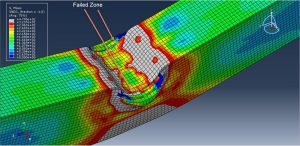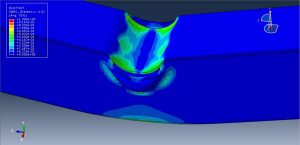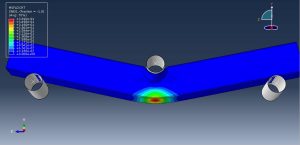In this tutorial, the Simulation flexural response of aluminum alloy profile in Abaqus- Damage investigation- has been studied. Aluminum alloys are used across a range of structural engineering applications, with square and rectangular hollow sections being a popular cross-section shape. This can be particularly beneficial for enhancing resistance to local buckling through, for example, the addition of internal stiffeners. In this study, the flexural behavior and ultimate bending capacity of square and rectangular hollow sections with internal cross stiffeners are investigated through experimentation and numerical modeling. The load-deflection histories of the test specimens, as well as the observed failure modes, are reported. Further data are also generated through finite element modeling. The aluminum profile is modeled as a three-dimensional shell part. You can see a figure of the assembled parts at below
The aluminum material is modeled as an elastic-plastic. To predict damage behavior some damage criterions are used. The first criterion is Ductile damage, The ductile criterion is a phenomenological model for predicting the onset of damage due to nucleation, growth, and coalescence of voids. The second case is Shear damage, The shear criterion is a phenomenological model for predicting the onset of damage due to shear band localization and the third case is MSFLD damage criterion, Müschenborn and Sonne proposed a method to predict the influence of the deformation path on the forming limits of sheet metals on the basis of the equivalent plastic strain, by assuming that the forming limit curve represents the sum of the highest attainable equivalent plastic strains. Abaqus makes use of a generalization of this idea to establish a criterion of necking instability of sheet metals for arbitrary deformation paths. The dynamic explicit step is used to model dynamic behavior under the bending process. The surface to surface contacts among rigid bodies and aluminum profiles with contact property is used. The fixed boundary condition is applied to bottom rigid bodies and displacement boundary for the top rigid body. The should be so fine to have a correct predict of damage and failure
After the simulation all results such as shear, ductile and MSFLD damage, stress, strain, force-displacement diagram…..can be achievable. You can see some figures for the result below







You can provide CAE ,INP,and English video files of this simulation here. The cost of these files is Twenty-Six Euros. you can click on the bellow bottom to beginning process
You can purchase the tutorial through a PayPal account, a Visa, or a Master card, just before payment,send me an email to this address: karampourp@gmail.com
 Abaqus tutorials Abaqus tutorials
Abaqus tutorials Abaqus tutorials




